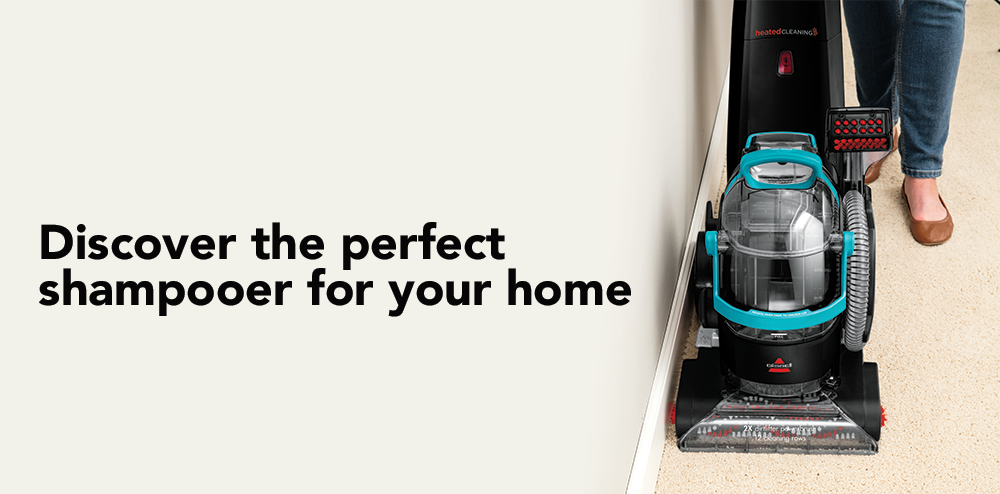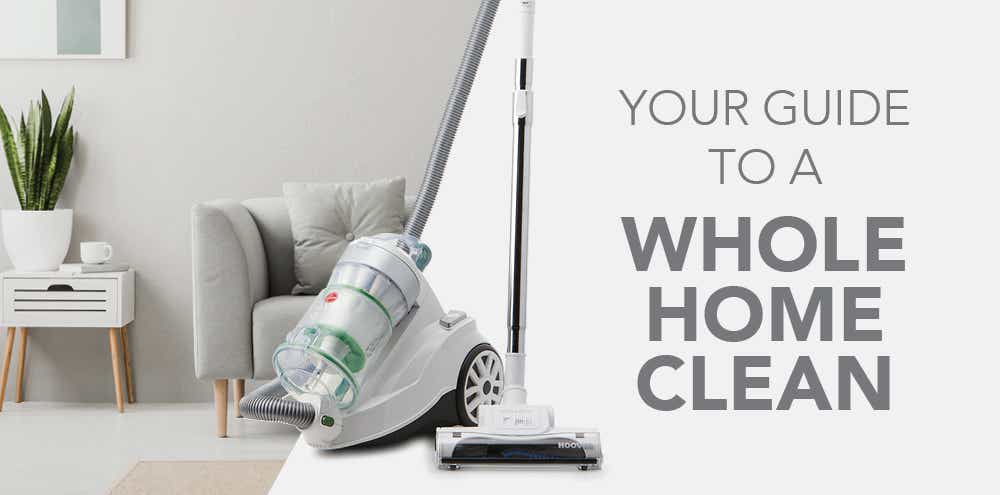A carpet shampooer will keep your carpets looking fresh and knock out those tough stains and odours trapped in the carpet fibres. Vacuuming alone isn’t enough to keep bacteria at bay – a carpet shampooer works to lift deeply embedded grime using a combination of water, detergent and suction.
How do you choose which carpet shampooer will suit your home? We’ll take you through everything you need to know so you can confidently choose the best carpet shampooer for you.
Benefits of Owning a Carpet Shampooer
There’s no need to outsource carpet cleaning to a professional when it’s so easy, and cost-effective, to DIY. A carpet shampooer is a practical, cost-effective investment for maintaining the longevity of your carpets.

Easy to Use
Most at-home carpet shampooers have a lightweight design, so they’re easy to manoeuvre around the home for quick carpet cleaning. You won’t have to be on your hands and knees scrubbing for ages at stubborn stains anymore.

Eliminates Trapped Pollutants
Carpet fibres trap allergens, dust particles and bacteria. And because the pesky pollutants sink low beneath the carpet’s surface, regular vacuuming can’t completely remove them – leaving them to build up over time. Carpet shampooing will kill these contaminants so they no longer pose a health threat.

Removes Stains, Dirt & Mould
Stubborn stains don’t stand a chance. An at-home carpet shampooer uses a combination of water, solution and suction to remove stains such as coffee or wine spills, pet urine, and dirt. Similarly, mould and mildew growth is preventable with a carpet shampooer – particularly one with a high-powered drying system.
Improves Look & Feel
Notice how nice your hair looks and feels after being washed? Carpets are the same. After shampooing, you carpet will look and feel fresh and clean. Regular carpet cleaning will also enhance the overall aesthetic of the home and return it to feeling brand new.
Extends Carpet Life
It’s easy to think a vacuum once or twice a week is enough to look after your carpet, but when dirt, debris, dust mites and bacteria continue to accumulate, it can cause the fibres to eventually discolour and deteriorate. Maintaining them with a carpet shampooer will improve the look and longevity of your carpet and protect it from wear and tear.
Types of Carpet Shampooers
There are 3 types of carpet shampooers to choose from: upright, handheld, and extraction units. Upright and handheld are the models generally used in households while extraction units are typically used for commercial purposes.
Upright Carpet Shampooers
Upright carpet shampooers are the most popular models. They are designed to deliver a professional cleaning result with minimal fuss. The best shampooers come equipped with a brush that provides a scrubbing action to effectively lift dirt that’s been deeply embedded in the fibres.
Pros:
- Lightweight, ergonomic design for manoeuvrability
- Trigger system for cleaning control
- Easy to maintain
- Some models come with attachments for hard floor and upholstery cleaning
Cons:
- Some models are noisy
Portable Carpet Shampooers
Perfect for spot cleans, portable carpet shampooers are designed to attend to stains quickly and easily, without needing to bring out the big guns.
Pros:
- Compact and lightweight design for easy portability
- Ideal to use on stairs, upholstery, car seats, and for spot cleans
- Cleans those hard-to-reach areas
Cons:
- Not suited to large-scale cleaning tasks
Carpet Shampooer Extraction Units
Carpet extraction machines are most commonly used for commercial cleaning purposes and cleaning carpets damaged by flooding.
Pros:
- Extra-large capacity tank
- Durable and heavy duty
- Usually come with attachments for upholstery and spot cleans
- Highly manoeuvrable and heavy-duty
Cons:
- Higher purchase costs
- Can be noisy
Picking the Right Carpet Shampooer
Consider all aspects when choosing your carpet shampooer – after all, you’ll hopefully be using it for a very long time. Features to keep in mind when shopping:
Tank Capacity
Larger tanks will help you cover more carpet between refills.
Head Width
A wider head will make it quicker to clean rooms, and you can use an upholstery attachment for stairs and smaller areas.
Maintenance
Look for a model where the dirty-water tank is easy to remove.
Performance
Choose a model with superior scrubbing action. This might come in the form of twin roller brushes or vibrating scrubbing brushes that work the cleaning solution into the carpet to help remove stains.
Temperature
The temperature of the water increases a carpet shampooer’s efficiency. Models with a self-heating ability are more effective and efficient.
Models with Specialised Attachments
Do you want to use your shampooer on hard floors, upholstery and mattresses? Choose a model that comes with extra tools to perform these tasks.
Your Home
Does your home have stairs? Do you own any pets? Do you just need something to attend to those spills as they happen? Consider all the factors related to your home and specific situation so you’re sure you’ve picked the model best suited to meet your requirements.
Tips for Using Your Carpet Shampooer
Carpet cleaning is easy to do yourself and means you’ll save big on what’s normally spent on hiring professional services. Once you’ve chosen the perfect carpet shampooer for your home, you’ll be set to tackle any cleaning situation.
How to Use a Carpet Shampooer
The steps for using a carpet shampooer will vary between the different types, so always check the manufacturer’s manual. For an upright carpet shampooer, the general steps are:
- Start by giving your carpets a thorough vacuum – a powerhead with a vibrating brush will provide a deep-down clean.
- There are two tanks – one for clean water and one to hold dirty water once you’ve begun shampooing. Fill the clean water compartment and add the cleaning solution per the manufacturer’s recommendation. Be sure to use a cleaning solution specifically made for carpet shampooing and recommended by the manufacturer.
- Attach both tanks firmly to the model and plug it in.
- Test the shampooer on a small section of the carpet (perhaps an area that sits under a piece of furniture) for colour fastness. Dampen a white cloth with solution. Gently rub the cloth over the area. Check for colour bleeding.
- If the cloth remains clean, it should be safe to clean the carpet. Begin shampooing your carpet by pushing it slowly over your carpet following a straight line. You’ll need to press a button or trigger to release the cleaning solution as you go.
- Release the trigger and pull the shampooer backwards to collect the dirty water. Repeat the above steps making your way up and down the room.
- Once finished, run a clean tank of water (no soap) over the cleaned areas to help remove any cleaning solution residue.
How to Dry Carpet After Cleaning
Some models will come with advanced drying technology which blows dry air as you clean. Otherwise you can try one or a combination of the following:
- Aerate the room with opened windows and doors.
- Turn on the ceiling fans.
- Plug in a couple of pedestal fans to speed up the drying process.
- Turn on air-conditioning if opening windows isn’t an option.
How Often Should Carpets be Cleaned?
As always, check with the manufacturer for cleaning instructions. Commonly, high-use carpeted areas should be cleaned once every 3-6 months, and the entire carpet should be cleaned at least once or twice a year.
But you don’t need to wait for these big cleans – owning your own shampooer means you can attend to spots and stains as they happen.
View the vast range of carpet shampooers available at Godfreys online or instore today.





